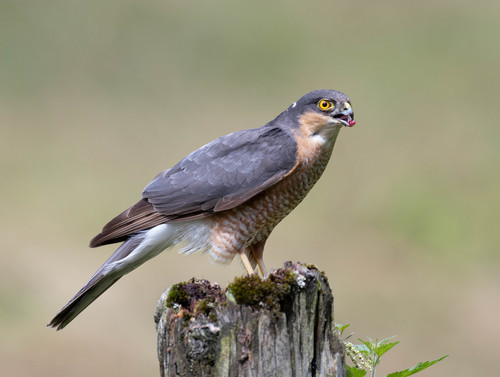
Eurasian Sparrowhawk
The Eurasian Sparrowhawk (*Accipiter nisus*) is a small, agile bird of prey widely distributed across Europe and Asia. It is a highly skilled hunter, primarily preying on smaller birds in woodland and urban environments. This species plays a crucial role in regulating songbird populations and is a significant indicator of ecosystem health. While not holding major cultural significance comparable to larger raptors, its presence has been noted in European folklore, often symbolizing speed and cunning.
28-38 cm
Length
55-70 cm
Wingspan
Least Concern
Conservation Status
Distribution
The Eurasian Sparrowhawk has a vast range, spanning across Europe, much of Asia (including parts of the Middle East and Siberia), and into North Africa. It is a partial migrant; northern populations often migrate south for the winter, while those in milder climates may be resident year-round. Altitudinal ranges vary, from sea level to mountainous regions.
Lifespan
Typical lifespan in the wild is around 4 years, but individuals can live up to 10 years or more.
Eurasian Sparrowhawk's Habitat
Habitat Types
Woodlands (coniferous, deciduous, and mixed), Farmland with hedgerows, Urban parks and gardens, Open country with scattered trees
Climate Zones
Temperate, Boreal, Mediterranean
Adaptations
Their short, rounded wings and long tail provide exceptional maneuverability in dense vegetation, enabling them to pursue prey through complex environments. Their sharp talons and hooked beak are perfectly adapted for capturing and consuming small birds.
Variations
Several subspecies are recognized, differing slightly in size and plumage coloration. For example, *Accipiter nisus granti*, found on the Canary Islands and Madeira, is smaller and darker than the nominate subspecies.
Appearance
Breeding Plumage
Adult plumage is relatively consistent throughout the year, although fresh plumage after molting may appear brighter.
Seasonal Feather Changes
Minor seasonal variations; plumage may appear slightly duller in winter.
Sex Based Plumage Differences
Males have bluish-grey upperparts and reddish-barred underparts. Females have brownish-grey upperparts and greyish-barred underparts. Juveniles are browner overall with streaked underparts.
Notable Features
Sharp, curved talons, Hooked beak, Bright yellow or orange eyes, Long tail
Diet and Feeding
Primary Foods
Small birds (sparrows, finches, tits), Occasionally small mammals (mice, voles), Rarely insects
Foraging Behavior
The Eurasian Sparrowhawk is an ambush predator. It often hunts by perching inconspicuously and launching surprise attacks on unsuspecting prey. It also uses fast, low-level flights along hedgerows and woodland edges to flush out birds.
Specializations
Their speed and agility, combined with sharp talons, make them highly effective bird hunters. Their relatively short wings allow for rapid acceleration in confined spaces.
Seasonal Diet Variations
Diet may shift slightly depending on prey availability. During the breeding season, they may focus on feeding their young with readily available fledgling birds.
Behavior
Social Structure
Generally solitary, except during the breeding season when they form pairs. They are not known for forming large flocks.
Communication
A rapid 'kew-kew-kew' call, often used during alarm or courtship, A softer 'kee-yer' call used between pair members, Visual displays, such as aerial maneuvers
Migration
Northern populations are migratory, flying south for the winter. Southern populations may be resident or only undertake short-distance movements.
Territorial or Group Behaviors
They are highly territorial during the breeding season, defending their nesting area from other sparrowhawks and potential predators.
Conservation
Threats
Habitat loss and fragmentation (due to deforestation and urbanization), Pesticide use (indirectly affecting prey populations), Collisions with windows and vehicles, Illegal persecution (though less common now)
Protection Programs
Monitoring of population trends, Habitat restoration and protection initiatives, Public awareness campaigns
Local National Laws
Protected under various national and international wildlife laws, including the EU Birds Directive.
Population Trend
Stable
Population Estimates
The global population is estimated to be in the millions, although precise figures are difficult to obtain.
Interesting Facts
Females are much larger than males
This size difference, known as sexual dimorphism, is common in birds of prey and may be related to different roles in hunting and nesting.
They can reach speeds of up to 50 km/h (31 mph) in short bursts
This speed is crucial for catching their fast-flying prey.
They have been used in falconry for centuries.
Their agility and hunting prowess make them suitable, though challenging, birds for falconry.
Faqs about Eurasian Sparrowhawk
What should I do if I find an injured Eurasian Sparrowhawk?
Contact a local wildlife rehabilitation center or veterinarian. Do not attempt to handle the bird yourself, as they have sharp talons and can be easily stressed. *Consult a professional for expert advice.*
Are Eurasian Sparrowhawks dangerous to humans?
No, they are not typically dangerous to humans. They are shy birds and will generally avoid contact with people. However, they may defend their nest aggressively if they feel threatened.
Do Eurasian Sparrowhawks eat garden birds?
Yes, they are natural predators of small birds, and garden birds can be part of their diet. Providing cover, such as dense shrubs, can help garden birds escape predation.
Copyright @ Nature Style Limited. All Rights Reserved.
 English
English